Cybernetics in a
Paradigm of Threes
The future of AI is contained
in this advanced theory.
Uses IBM technology
as a baseline for understanding.
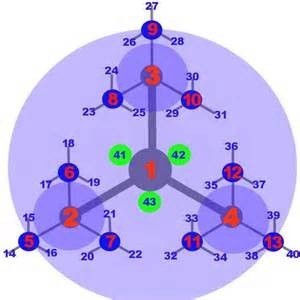
It only stands to reason that for Artificial Intelligence to succeed, long term, it must emulate the capabilities of the human brain. This is the area of technology called cybernetics. Nevertheless, even at its beginnings, AI is a reality changing all our lives, our perceptions and our participation in society. What is happening currently in the field of AI can be compelling and even overwhelming. But we are nowhere near the successful application of cybernetics. In fact, cybernetics does not exist today. So where are we in reference to the maturity of AI and seeing large scale implementations of it in the corporate world. To help understand AI let's use IBM technology and strategies as a foundation. Today at IBM there is Watson and Watson X. Watson represents an evolutionary step toward Artificial Intelligence. It is interesting to note that the eLiza project at IBM hinted at aspects of cybernetics. This is true because eLiza opens the discussion for ternary computing and self managed and self regulating systems. Confirming ternary and its relevance to AI please refer to this presentation. Therefore, binary computers are limited in their ability to process trivalent logic. Moreover, they cannot be anticipated to process information like the human brain. Therein lies the opportunity.
Irrespective of the controversial comments that you read and hear about AI, it is here. It will positively impact all our lives. One might wonder, how is this possible? Again, modeling IBM, it is both a computer company of today and of tomorrow. Just as there are few ternary computers today, there are no androids and no vision of future technology based on ternary research. Despite all these limitations the computer industry is impatient to make AI happen today. That can prove to be impractical without understanding current technology, its advantages, as well as its limitations. So it is important to appropriately set the stage to enable AI technology. For large corporations this points to the value of enterprise modeling and is the beginning of an AI implementation for a large corporation.
By modeling IBM or any major technology company with the paradigm of threes it is possible to unlock the inventiveness of that company. These efforts will make it possible to take AI into the mainstream and also facilitate ternary computing. This point cannot be overstated, as the future of all computer technology eventually will be impacted by this theory of threes. Therefore, by looking at IBM, or any major technology company, through paradigm of threes theory, it may be possible to invent and derive the future of that company. In some cases that could (theoretically) be over 75 to 100 years ahead of the marketplace. These were the premises proposed over 30 years ago in IBM Blueprint 2000. Time has definitively proven the validity of the paradigm of threes related to computer technology. All major computer and software corporations were presented with the concept; and, all could see the correlation between paradigm of threes and the future of AI.
Without threes theory the computer industry is generally limited by binary computers and binary logic. Therefore, beyond today’s mainframes, quantum and super computers, paradigm of threes research indicates 75 to 100 years from now the computer industry will be producing ternary, optical supercomputers. They will be based on a triaxle Chrystal Chip. The caching algorithm will use Algorithm Language Three. This is to be a human language based caching algorithm. Bear in mind that some of these ideas are beyond practical development in the short term. They do, however, serve as a baseline to help understand how the future of AI technology can unfold using some aspects of mainframe technology. Transitioning from the binary to the ternary era of computing is approximated to still be a futuristic vision. However, understanding today's AI is important and understanding the ternary era is essential to pave the way for sentient computers and cybernetics. By extrapolation inventing and deriving the future of technology with paradigm of threes theory an automaton was discovered to be a possibility. This was discovered in research in the summer of 1990. Through a process of "electrotelepathy" massive clusters of ternary computers _FIL_ are linked via atomic thinking units _ATU_ within an automaton, at least in theory. But what is a valid theory, and how can you tell?
Without threes theory the computer industry is generally limited by binary computers and binary logic. Therefore, beyond today’s mainframes, quantum and super computers, paradigm of threes research indicates 75 to 100 years from now the computer industry will be producing ternary, optical supercomputers. They will be based on a triaxle Chrystal Chip. The caching algorithm will use Algorithm Language Three. This is to be a human language based caching algorithm. Bear in mind that some of these ideas are beyond practical development in the short term. They do, however, serve as a baseline to help understand how the future of AI technology can unfold using some aspects of mainframe technology. Transitioning from the binary to the ternary era of computing is approximated to still be a futuristic vision. However, understanding today's AI is important and understanding the ternary era is essential to pave the way for sentient computers and cybernetics. By extrapolation inventing and deriving the future of technology with paradigm of threes theory an automaton was discovered to be a possibility. This was discovered in research in the summer of 1990. Through a process of "electrotelepathy" massive clusters of ternary computers _FIL_ are linked via atomic thinking units _ATU_ within an automaton, at least in theory. But what is a valid theory, and how can you tell?
A theory represents systematically organized knowledge applicable in a relatively wide variety of circumstances, especially a system of assumptions, accepted principles, and rules of procedure devised to analyze, predict, or otherwise explain the nature or behavior of a specified set of phenomena. It requires abstract reasoning; speculation. It is a belief that guides action or assists comprehension or judgment. It is also an assumption based on limited information or knowledge; a conjecture. Then why pursue theories?
A theory offers a model of proving and verifying the correctness of a futuristic concept. This requires a consciously directed concentration of the powers of reasoning to assemble all related thoughts of a given subject. Abstraction and then theory application allows one to analyze, penetrate and hopefully understand the reality of a concept. Theory application is very important as it disciplines thought processes and helps the human mind to understand and grasp exceptionally complicated structures, ideas and concepts.
A paradigm of threes theory appears as a unifying set of methodologies, with the results as variations on a theme. The theme manifests itself in a consistent and repeatable way. Then non-technicians observe evidence to support the premises of the theory. Surprisingly, this occurs for a valid theory regardless of all that is going on in an industry. This is why an AI vision is so important and why you will be able to see the evidence to support this cybernetic theory.
Threes theory universally makes a visionary statement about the computer industry. This statement impacts current knowledge with a confirming effect in business and industry. In more depth analysis, so what’s new and different? Most modern-day computers have been designed by the application of a two-position electric switch. Binary computers have software that is layered with graphical user interfaces. These interfaces hide the binary codes that computers understand, the 1's and 0's. But paradigm of threes theory proposes that computer technology would work better if using base 3, instead of base 2. This is also known as trivalent logic or three value logic. This is partially possible today using SQL (Structured Query Language), but ternary CPU's are not reflected in the vast majority of machine designs.
Bear in mind that there are different forms of ternary computing. However, balanced ternary appears to be most similar to the functioning of the human mind. Nevertheless, the few ternary computers that exist today are not very impressive because the migration to ternary is more complex than simply making a machine. Most of them are likely running binary software on a ternary machine and are not exploiting the value of ternary. Specifically, they are using the +1 and -1, but ignoring the 0 (null value). In order for ternary computing to be significant to AI it will require a completely new type of operating system and also programming to take advantage of it. In short, more of a logical rather than a physical operating system is needed. This will allow the operating system to execute apps that are both binary and ternary and also be hardware platform independent.
Currently the Linux Operating System is the only Logical Operating System in the marketplace. However, it was not designed for ternary computing. Currently, the mainframe zOS is the most complex operating system as it controls the jobs (apps) that run on a mainframe. The most remarkable thing about zOS is that it is the closest thing to an Object Oriented Operating System in the computer industry. The three components of Object Orientation are Encapsulation, Inheritance and Polymorphism. The most intriguing aspect of zOS is the aspect of Polymorphism. At run time the Job Control Language can be programmed to take on different forms. Moreover, this mainframe operating system uses Inheritance from one job step to another. And, finally, it can be programmed for Encapsulation. Job steps can be completely ignored, bypassed or using dummy (null) files. Therefore, from a RPC it can select what steps to execute, dynamically name and rename files and address check point restart and recovery procedures. These components of Object Orientation are needed today and mirror aspects of ternary computing. This coupled with exploiting the ternary aspect of hardware design will provide a significant leap forward in AI. In short, the power, flexibility and incredible memory management of a mainframe could be available to an individual, an app or a legacy mainframe app. with the simple click of a mouse, touch of a finger or a voice command. But how was this assessment determined?
Bear in mind that there are different forms of ternary computing. However, balanced ternary appears to be most similar to the functioning of the human mind. Nevertheless, the few ternary computers that exist today are not very impressive because the migration to ternary is more complex than simply making a machine. Most of them are likely running binary software on a ternary machine and are not exploiting the value of ternary. Specifically, they are using the +1 and -1, but ignoring the 0 (null value). In order for ternary computing to be significant to AI it will require a completely new type of operating system and also programming to take advantage of it. In short, more of a logical rather than a physical operating system is needed. This will allow the operating system to execute apps that are both binary and ternary and also be hardware platform independent.
Currently the Linux Operating System is the only Logical Operating System in the marketplace. However, it was not designed for ternary computing. Currently, the mainframe zOS is the most complex operating system as it controls the jobs (apps) that run on a mainframe. The most remarkable thing about zOS is that it is the closest thing to an Object Oriented Operating System in the computer industry. The three components of Object Orientation are Encapsulation, Inheritance and Polymorphism. The most intriguing aspect of zOS is the aspect of Polymorphism. At run time the Job Control Language can be programmed to take on different forms. Moreover, this mainframe operating system uses Inheritance from one job step to another. And, finally, it can be programmed for Encapsulation. Job steps can be completely ignored, bypassed or using dummy (null) files. Therefore, from a RPC it can select what steps to execute, dynamically name and rename files and address check point restart and recovery procedures. These components of Object Orientation are needed today and mirror aspects of ternary computing. This coupled with exploiting the ternary aspect of hardware design will provide a significant leap forward in AI. In short, the power, flexibility and incredible memory management of a mainframe could be available to an individual, an app or a legacy mainframe app. with the simple click of a mouse, touch of a finger or a voice command. But how was this assessment determined?
As applied to the computer industry parallels emerge presenting empirical evidence to support threes theory. First, is the application of the theory to computer hardware and architectures. This area demonstrates three-tier becoming pre-emergent over all large computer architectures, as well as clusters of three computers appearing. Second, is software and the software development life cycle. This relates to application development of software, exploration of formal metrics and presenting the idea of sentient and autonomic computing. Third, is the identification of patterns of three to marketing in business and industry. All told, this assessment only highlights this theory application. Bear in mind that most existing methods and metrics are theoretically unsound and intuitively unpersuasive. It is this point of vision in the computer industry that has created value in looking at the computer industry with a theory. It asks the question, “is there empirical evidence to support a paradigm of threes concept applied to the computer industry?”
If valid, this theory would have to be highly applicable to the computer industry. Moreover, the limitations of the binary architecture would hint at three tier and trinary concepts. If looking for this type of confirmation, it starts with IBM’s Systems Application Architecture (SAA). Before SAA, there was little to support threes theory. IBM announced this architectural initiative in the spring of 1987. Before SAA there were no multi-tier computer architectures. Everything was on a PC, a server or a mainframe. Unique to SAA was the presentation of a three-tier architecture, including interoperability between PC's, servers and mainframes. This was five years before the computer industry started to explore the concept of client-server, generally a binary or two-tier architecture. Soon after, SAA became a misunderstood idea. Nevertheless, SAA was based on a futuristic scientific phenomenon, specifically, a paradigm of threes.
Confirmation of paradigm of threes is well documented and can be found in IBM Systems Journals. For example, the Enterprise Information System documents contain an architectural blueprint for workstations, mid-range and large computer systems. It has three components,
Common User Access
Common Programming Interface
Common Communication Support
Systems Application Architecture was the first three-tier architecture presented to the computer industry. Conjecture indicates trinary concepts predict the obsolescence of binary computers. Then all software would need to enable trinary instead of binary architectures. Conclusion, SAA was ahead of its time. Therefore, at some future time all computers that currently exist will be replaced with those having three-position switch technology. This is the basis of a ternary future, and most of the products of its application exist well into the future.
Since this concept obsoletes all software currently in existence. How could something this advanced find relevance in today's world of commercial software development? This answer can be found in software, or methods of software development. Again a confirmation of threes theory can be found in an IBM strategy, specifically AD/Cycle. AD or Application Development has three models...
Enterprise Model
Design Model
Technology Model
The process of enterprise modeling controls and directs many aspects of creative license, specifically computer knowledge and enthusiasm. For enterprise modeling there are components of IBM’s RUP or CASE Technologies (e)Business Architect. These are enterprise modeling tools that grew out of AD/Cycle. Today we have Watson x governance to accelerate responsibility, transparency and explainability in AI workflows for business. The "how" to improve things would appear to find fulfillment with enterprise modeling. But why use a paradigm of threes modeling metric?
Bear in mind that there are growing number of computer scientists who confirm that human minds process information with a trinary, rather than a binary method. Then the logical assumption is that computers and software work better if based on a threes concept. This is the primary hypothesis. Specifically, if computers and software were modeled after the human brain artificial intelligence could rapidly expand into the mainstream. Not only would AI mimic human thought processes but could then be anticipated to become sentient. To support these premises variations on a theme would need to present themselves to the computer industry; otherwise, a premise of theoretical universality fails. Now let us look more deeply into some of IBM's strategies; again, the AD/Cycle. Its repository has…
A Conceptual View
A Storage View
A Logical View
Again, the threes pattern occurs with a
Specification Level
Implementation Level
Operational Level
As threes theory is valid, the logical and enterprise models proposed years ago still represent futuristic ideas to business and industry. However, it does cause confusion. If these ideas were ahead of the marketplace in 1987, then where is the three-tier concept now? More recently note IBM's MVC, J2EE Architectural Strategy. It appears to be based on threes theory and looks similar to previous three tier architectural blueprints. Therefore, to answer the premise of the theory, large computer architectural strategies are perpetually based on patterns of three. This is the basis of IBM's AI Vision. See MVC samples as follows.
The performance architecture has these levels of modeling (Model, View, Controller). The Model View Controller (MVC) application architecture helps in design and analysis. Its architecture is a way to divide functionality among objects involved in maintaining and presenting data so as to minimize the degree of coupling between the objects. The MVC architecture was originally developed to map the traditional input, processing, and output tasks to the graphical user interaction model. However, it is easy to map these concepts into the domain of multi-tier Web-based enterprise applications. Three parts define the separation of these areas.
1) Controller - Manages and controls all interactions between the user and the application. Usually the controller is a servlet that receives the user request and passes the input parameters to the model that does the work. Also, when the business process ends, it controls the creation of the View. The Application Development Life Cycle phases are composed of a...
Logic model
IT Component model
Enterprisewide model
2) Model - Encapsulates the business logic, rules, and data, and does the business processing, usually implemented by Enterprise Java Beans or EJBs. Initiation, design, development, test, transition and production with EJBs contain these three logical tiers…
Presentation logic
Controller logic
Business logic
3) View - Uses the results of the business processes and constructs the response presented to the user, usually implemented through Java Server Pages (JSP's).
This pattern of threes can also be found in the IBM's mainframe Parallel Sysplex coupling technology. Specifically, the heart of the Parallel Sysplex coupling facility provides three behavioral models to enable efficient clustering protocols: Lock model, Cache model, Queue Model. The Cache structure architecture supports three caching protocols, Directory-only cache, Store-through cache, Store-in cache.
The most advanced mainframe computer architecture is based on a paradigm of threes. Paradoxically IBM is a highly inventive company, however, the most advanced ideas are based on threes theory. If you are uncertain about how to react to this information, simply, how difficult could patterns of threes become? Review IBM’s Triplex Mainframe cluster, this helps demonstrate how the application of paradigm of threes theory provides futuristic insights. In the interim take the time to look for these paradigms of three. They can be intriguing and distracting. They're here. They're there. They're everywhere.
The most advanced mainframe computer architecture is based on a paradigm of threes. Paradoxically IBM is a highly inventive company, however, the most advanced ideas are based on threes theory. If you are uncertain about how to react to this information, simply, how difficult could patterns of threes become? Review IBM’s Triplex Mainframe cluster, this helps demonstrate how the application of paradigm of threes theory provides futuristic insights. In the interim take the time to look for these paradigms of three. They can be intriguing and distracting. They're here. They're there. They're everywhere.
Do note, beyond this research of IBM strategies additional patterns of threes are found. For example, cognitive analysis. Cognitive analysis is the basis for knowledge engineering. Expert systems need to capture expert knowledge in software. This requires working with a human expert and figuring out what they know. It also includes an analysis of how they tie together varying facts to reason about the problems that they solve.
As all minds (inadvertently) use a threes concept to think, to reason and to organize thoughts here is additional empirical evidence. Also, there are indications that minds describe and classify knowledge by the application of threes theory. For this example there are three ways to classify knowledge.
Heuristic knowledge
Domain knowledge
Theoretical knowledge
Using a hierarchy or classification that explains response data approaches the process of cognitive analysis. Chunking is a term to describe a process where people group objects together into some more abstract high level object. Human memory is composed of different hierarchies, each containing different domains. This hierarchy illustrates three levels of chunks or objects. A domain theory is derived from more than one deep theory. Drawing a parallel to computer software development and expert systems, a procedural model for software includes…
Inquiry rules
Recognition rules
Transfer rules
When applying a threes metric a knowledge, software or expert systems engineer has three types of tools for analyzing cognitive tasks.
Intellectual tools
Notation tools
Empirical tools
Summarizing, threes theory focuses the computer industry's AI vision based on old premises that were ahead of their time. Paradigm of threes would, therefore, represent a breakthrough for the computer industry and all hardware suppliers. Then, what's the value of paradigm of threes at this time? Today three-tier concepts and methods could be applied to better understand aspects of directing computer architectural initiatives. This is especially true for PC and mobile systems linked to mainframe systems for security, interfaces and recoverability. Therefore, the three-tier initiatives of the late 1980's and early 1990's stand as a ternary vision in a period of rapid expansion and then increasing complexity in technology. Yet they all have the same theoretical foundation. That foundation is universally in patterns of three.
Seldom discussed these days in the wake and success of Watson are the autonomic computer initiatives. They are hoping to eventually create sentient computers. As the evidence supports the theory, sentient computers could be achieved by applying the threes metric; "self-help, self-healing, self-diagnostic" or "self-configuring, self-optimizing, self-protecting". eLiza is IBM’s vision of a sentient computer. ELIZA was originally a computer program that simulates a conversation with a human, using natural language processing techniques. At that time it was over fifty years ahead of the marketplace. It was developed in the 1960s by Joseph Weizenbaum, a computer scientist and professor at MIT. ELIZA was one of the first programs to use natural language processing to simulate human conversation, and it became a popular research tool for studying human-computer interaction. Later it was briefly revisited by IBM relating to self-managed systems mainly for mainframe technology. Watson is, therefore, best described as a stepping stone to help enable more advanced AI concepts, such as eLiza. With time and the application of paradigm of threes theory it will be possible for computers to learn how to think. This theory presents the evidence as a shadowing effect of how this occurs. In short, if you construct a computer brain like a human brain, then it becoming intelligent is definite. Therefore, the future of AI computing is unquestionably ternary.
As a final point the application to marketing presents consistent and repeatable patterns of three. The paradigm of threes marketing concept would therefore be of futuristic significance as it represents a shadow or a trace of human cognitive thought processes. Look for them and you will be able to find them quite easily (below). The paradigm of threes will be with us from now to the end of time.
Eye it. Try it. Buy it.
Best Haulers. Best Savers. Best Sellers.
It pays in all ways to buy Chevrolets.
First in style. First in comfort. First by far with a post war car.
Over the phone. Over the web. Over the desk.
Your life. Your style. Your card.
For now. For later. For life.
Star light star bright first star I see tonight.
Snug as a bug in a rug.
No shirt. No shoes. No service.
Too much. Too little. Too late.
Want it. Need it. Cheez it.
Truly Madly Deeply
Snug as a bug in a rug.
No shirt. No shoes. No service.
Too much. Too little. Too late.
Want it. Need it. Cheez it.
Truly Madly Deeply

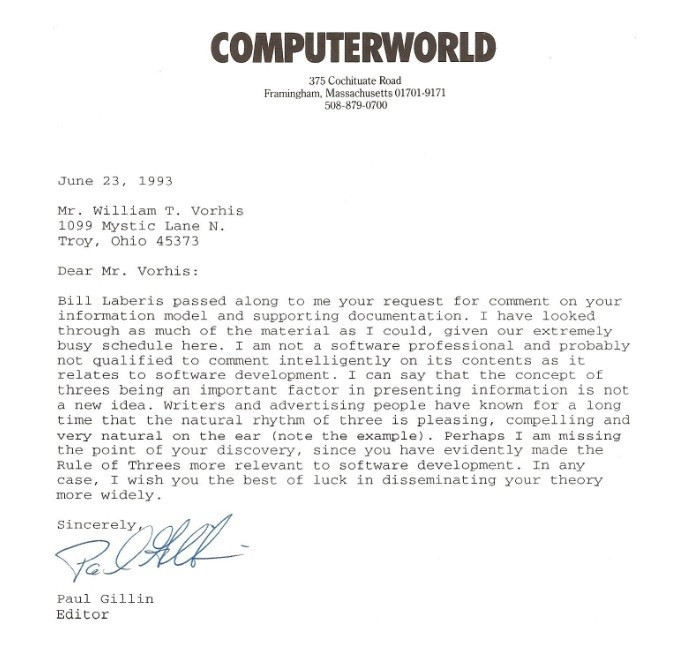
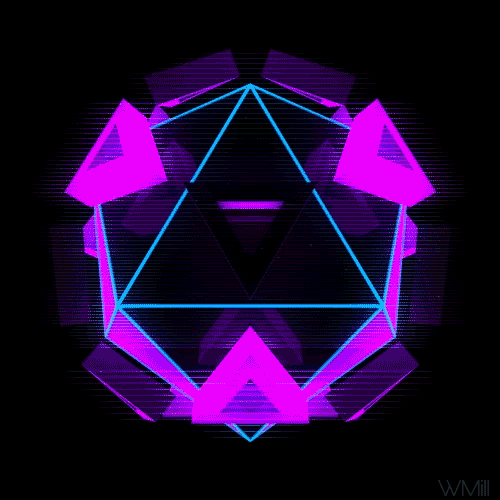
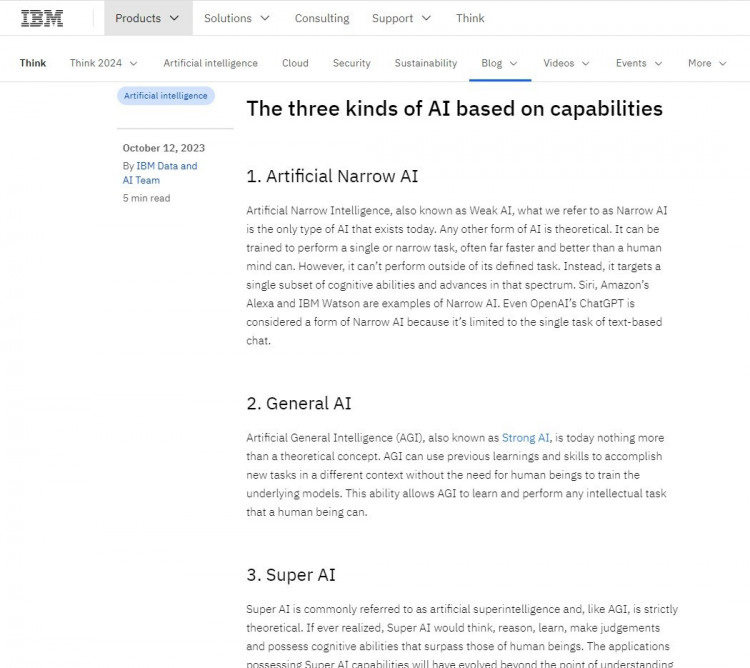
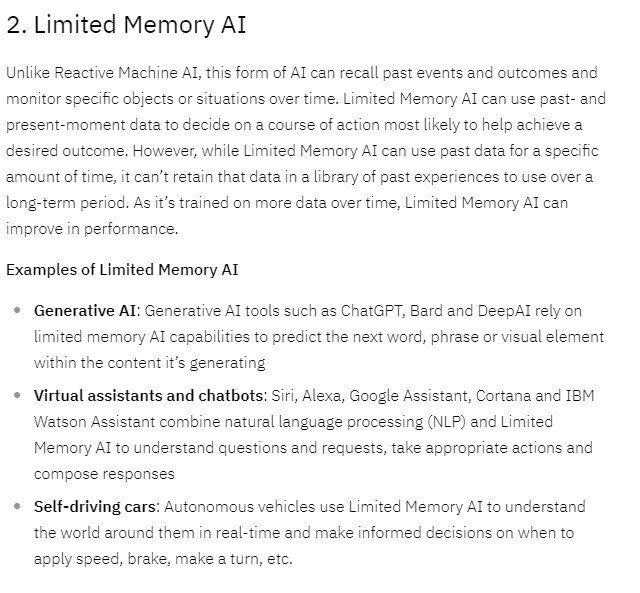
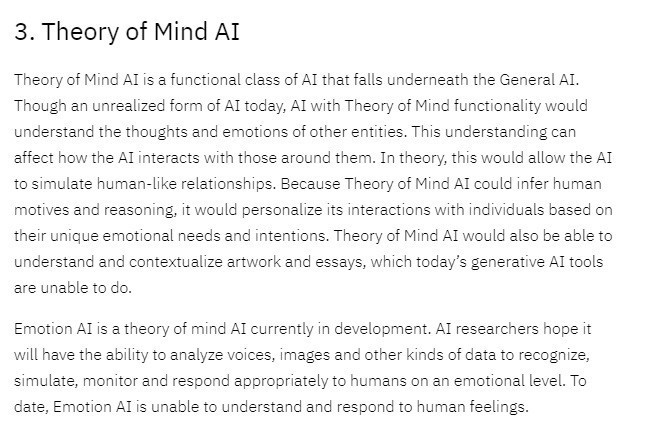
1.
2.
3.
.
Atomic Thinking Unit
